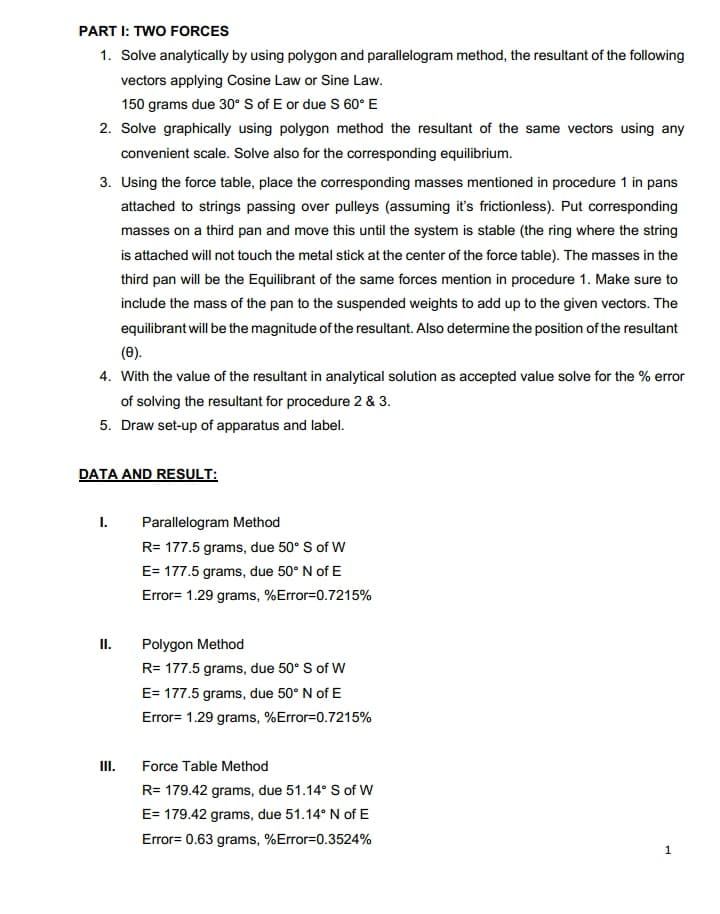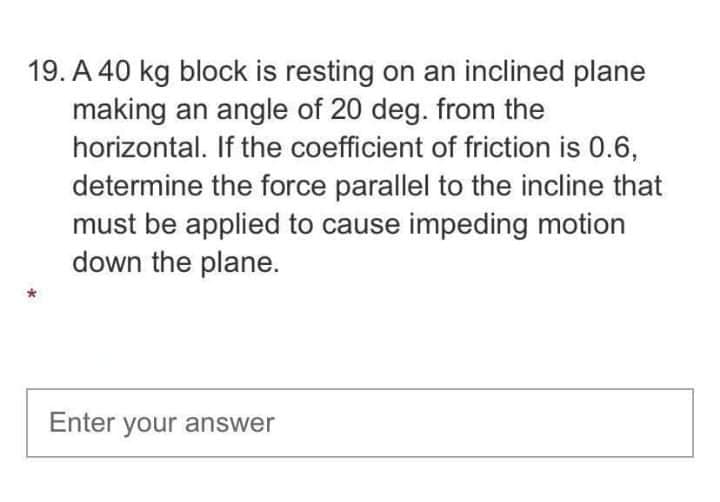19. A 40 kg block is resting on an inclined plane making an angle of 20 deg. from the horizontal. If the coefficient of friction is 0.6, determine the force parallel to the incline that must be applied to cause impeding motion down the plane.
19. A 40 kg block is resting on an inclined plane making an angle of 20 deg. from the horizontal. If the coefficient of friction is 0.6, determine the force parallel to the incline that must be applied to cause impeding motion down the plane.
University Physics Volume 1
18th Edition
ISBN:9781938168277
Author:William Moebs, Samuel J. Ling, Jeff Sanny
Publisher:William Moebs, Samuel J. Ling, Jeff Sanny
Chapter5: Newton's Law Of Motion
Section: Chapter Questions
Problem 100CP: Two forces are acting on a 5.0-kg object that moves with acceleration 2.0m/s2 in the positive y...
Related questions
Topic Video
Question
5 & 6

Transcribed Image Text:PART I: TWO FORCES
1. Solve analytically by using polygon and parallelogram method, the resultant of the following
vectors applying Cosine Law or Sine Law.
150 grams due 30° S of E or due S 60° E
2. Solve graphically using polygon method the resultant of the same vectors using any
convenient scale. Solve also for the corresponding equilibrium.
3. Using the force table, place the corresponding masses mentioned in procedure 1 in pans
attached to strings passing over pulleys (assuming it's frictionless). Put corresponding
masses on a third pan and move this until the system is stable (the ring where the string
is attached will not touch the metal stick at the center of the force table). The masses in the
third pan will be the Equilibrant of the same forces mention in procedure 1. Make sure to
include the mass of the pan to the suspended weights to add up to the given vectors. The
equilibrant will be the magnitude of the resultant. Also determine the position of the resultant
(0).
4. With the value of the resultant in analytical solution as accepted value solve for the % error
of solving the resultant for procedure 2 & 3.
5. Draw set-up of apparatus and label.
DATA AND RESULT:
I.
Parallelogram Method
R= 177.5 grams, due 50° S of W
E= 177.5 grams, due 50° N of E
Error= 1.29 grams, %Error=0.7215%
II.
Polygon Method
R= 177.5 grams, due 50° S of W
E= 177.5 grams, due 50° N of E
Error= 1.29 grams, %Error=0.7215%
I.
Force Table Method
R= 179.42 grams, due 51.14° S of W
E= 179.42 grams, due 51.14° N of E
Error= 0.63 grams, %Error=0.3524%
1

Transcribed Image Text:19. A 40 kg block is resting on an inclined plane
making an angle of 20 deg. from the
horizontal. If the coefficient of friction is 0.6,
determine the force parallel to the incline that
must be applied to cause impeding motion
down the plane.
Enter your answer
Expert Solution
This question has been solved!
Explore an expertly crafted, step-by-step solution for a thorough understanding of key concepts.
This is a popular solution!
Trending now
This is a popular solution!
Step by step
Solved in 2 steps with 2 images

Knowledge Booster
Learn more about
Need a deep-dive on the concept behind this application? Look no further. Learn more about this topic, physics and related others by exploring similar questions and additional content below.Recommended textbooks for you

University Physics Volume 1
Physics
ISBN:
9781938168277
Author:
William Moebs, Samuel J. Ling, Jeff Sanny
Publisher:
OpenStax - Rice University


Glencoe Physics: Principles and Problems, Student…
Physics
ISBN:
9780078807213
Author:
Paul W. Zitzewitz
Publisher:
Glencoe/McGraw-Hill

University Physics Volume 1
Physics
ISBN:
9781938168277
Author:
William Moebs, Samuel J. Ling, Jeff Sanny
Publisher:
OpenStax - Rice University


Glencoe Physics: Principles and Problems, Student…
Physics
ISBN:
9780078807213
Author:
Paul W. Zitzewitz
Publisher:
Glencoe/McGraw-Hill

College Physics
Physics
ISBN:
9781938168000
Author:
Paul Peter Urone, Roger Hinrichs
Publisher:
OpenStax College